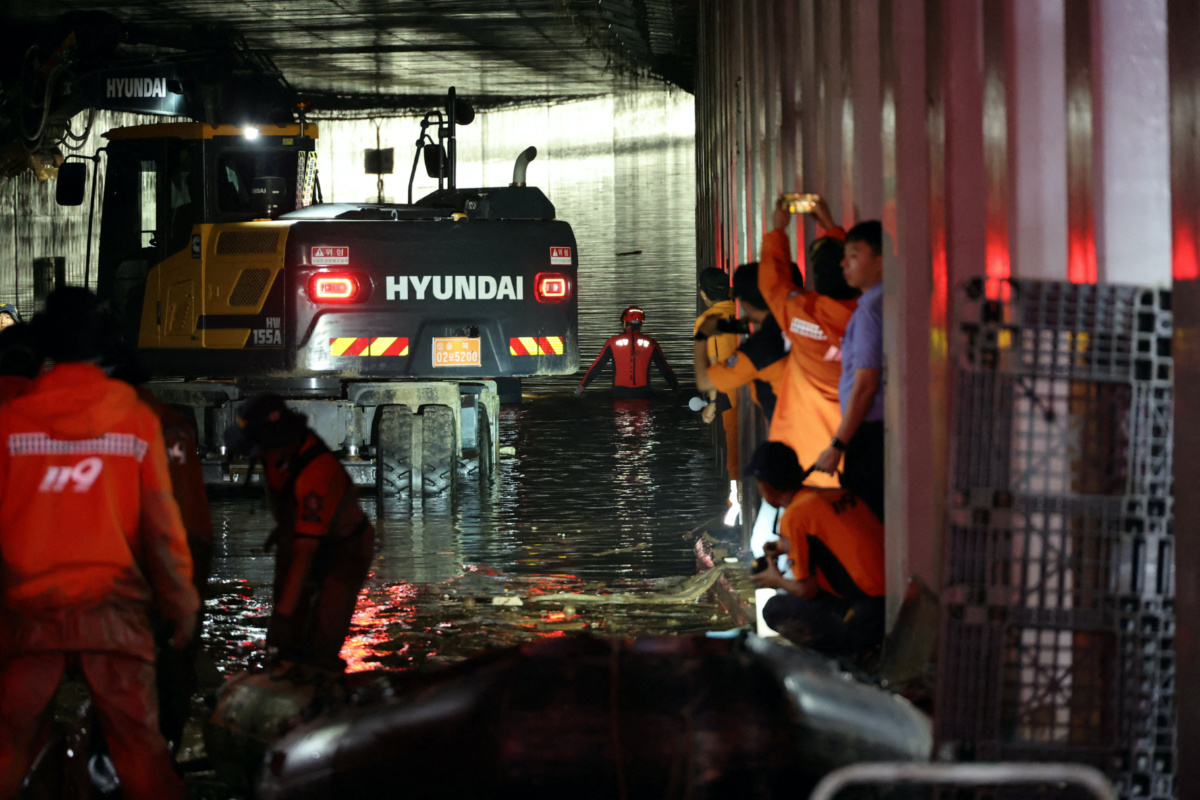Seoul, South Korea
Reuters
A year after South Korea vowed to step up readiness for extreme weather driven by climate change, experts say not enough work has been done even as greater volumes of sudden and torrential rains are expected in coming decades.
Forty or more people have lost their lives in less than a week of heavy rains – including 13 who died when floodwaters trapped them in an underpass in the city of Cheongju – casting doubt on the country’s efforts to prepare for localised and intense downpours.

Rescue workers take part in a search and rescue operation inside an underpass that has been submerged by a flooded river caused by torrential rain in Cheongju, South Korea, on 17th July, 2023. PICTURE: Yonhap via Reuters
Experts say the pledge for better preparation has not been followed by setting aside the monies needed, while spending remains too focused on recovery and not enough on prevention.
Jeong Chang-sam, an engineering professor at Induk University in Seoul specialising in water resources, said prevention is crucial to minimising damage and the loss of lives, but it is often neglected because the benefits are not immediately obvious to politicians and those in government.
“People like to use expressions such as rapid response, emergency recovery…but climate disasters are already underway,” Jeong said.
“If you put money into prevention projects, you can do it at half the cost of recovery projects,” he said.
Jeong cited the example of a plan for installing remote-controlled access barriers at underpasses, set up after a flood in Busan trapped and killed three motorists in 2020. The plan never moved forward in many areas susceptible to flash floods, including Cheongju, he said.
President Yoon Suk Yeol on Monday echoed a call he made last year, when flooding in August from the heaviest rain to hit Seoul in 115 years paralysed commercial areas and inundated low-lying neighbourhoods in the affluent Gangnam district.
“This type of extreme weather is going to become the norm so we need to manage it as the norm, and we totally need to get rid of the idea that we can’t do anything about unusual circumstances,” Yoon told a disaster response meeting.
Officials have promised to spend more on natural disaster prevention after the country committed about two trillion won ($US1.6 billion) in 2022, 20 per cent more than what was spent the previous year, according to the interior ministry.
South Korea is mountainous and urban development has left many regions vulnerable to landslides, while readiness to respond to extreme weather has not been up to speed.
A 2020 study by the Korea Meteorological Administration found that property damage costs and casualties from extreme weather have tripled compared to the yearly average of the previous decade.
Cheongju, where the flash flood killed 13, is a recent suburban development, a transport hub serving the administrative capital of Sejong. The area lies next to a river and on Saturday a levee broke in an spot slated for more construction.
Jung Ki-cheol, a hydro-engineer at the Korea Environment Institute, said while annual average rainfall is not expected to increase dramatically between 2021 and 2040, a sharp increase in “extreme downpours” is likely due to climate change.
“In particular, disaster damage due to floods will continue to increase as not only the extreme precipitation but also the number of days of precipitation increase,” Jung said in a report published in December.
We rely on our readers to fund Sight's work - become a financial supporter today!
For more information, head to our Subscriber's page.
The past week’s victims include 20 killed or missing in mountainous North Gyeongsang province, many from landslides.
Jeong of Induk University said authorities who were too slow to act on available information and who had not created a system to alert residents could be blamed for the casualties.
Lee Su-gon, a former civil engineering professor at the University of Seoul, estimated there are “more than a million locations” in the country susceptible to landslides but said only a tenth of those are monitored by authorities.
Lee also said regional governments were more focused on spending on recovery than prevention when it comes to natural disasters.
“When it comes to allocating disaster budgets, local [South Korean] governments use 30 per cent of that for prevention measures and 70 per cent is used for recovery after disasters,” he said.
“In advanced countries, they allocate 70 per cent for prevention and 30 per cent for recovery, prioritising recovery over prevention.”
– With HYUNSU YIM






